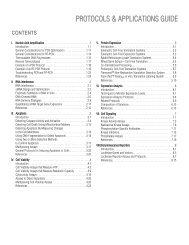2012 Promega catalogue
2012 Promega catalogue
2012 Promega catalogue
Create successful ePaper yourself
Turn your PDF publications into a flip-book with our unique Google optimized e-Paper software.
Cell Signaling<br />
Beta-Glo ® Assay System<br />
Product Size Cat.# Price ($)<br />
Beta-Glo ® Assay System 10 ml E4720 154.00<br />
For Research Use Only. Not for Use in Diagnostic Procedures.<br />
100 ml E4740 1062.00<br />
10 × 100 ml E4780 Pls. Enq.<br />
Description: The Beta-Glo ® Assay System is a homogeneous method of<br />
quantitating β-galactosidase expression in mammalian cells. The system<br />
provides a bright luminescent signal that is stable over several hours in<br />
commonly used cell culture medium without prior sample processing. The<br />
homogeneous assay procedure involves the addition of a single reagent directly<br />
to cells cultured in serum-supplemented medium. Throughput rates of several<br />
thousand samples per hour may be achieved with high reproducibility under<br />
standard laboratory conditions.<br />
Features:<br />
• Bright Luminescent Signal: Quantitate with confidence using lowvolume<br />
formats or in samples with low-level expression.<br />
• Homogeneous Format: Perform fewer steps. Add a single reagent<br />
directly to cells in growth medium.<br />
• Stable Signal: Obtain flexibility and convenience when processing multiple<br />
plates.<br />
• Convenient: Achieve optimal assay performance at room temperature.<br />
• Flexible: Read the luminescent signal using any luminometer. Injectors are<br />
not required.<br />
• Choose Your Configuration: Learn more about our custom options for<br />
this product at: www.promega.com/myway/<br />
Storage Conditions: Store at –20°C.<br />
Protocol Part#<br />
Beta-Glo ® Assay System Technical Manual<br />
TM239<br />
Log Luminescence (RLU)<br />
6<br />
5<br />
4<br />
3<br />
2<br />
1<br />
0<br />
Control Protein 1 Protein 2<br />
Beta-galactosidase activity determined using the Beta-Glo ® Assay<br />
System with a yeast two-hybrid system. Image kindly provided by Dr.<br />
Brad Hook, Ph.D., University of Wisconsin, Madison.<br />
For complete and up-to-date product information visit: www.promega.com/catalog<br />
6042MA<br />
CAT Reporter Systems<br />
CAT Enzyme Assay System<br />
Product Size Cat.# Price ($)<br />
CAT Enzyme Assay System 50 reactions E1000 203.00<br />
Available Separately Size Conc. Cat.# Price ($)<br />
Chloramphenicol Acetyltransferase 100 u 10–14 u/µl E1051 82.00<br />
n-Butyryl CoA 255 µl 5 mg/ml E1061 103.00<br />
Reporter Lysis 5X Buffer 30 ml E3971 108.00<br />
For Research Use Only. Not for Use in Diagnostic Procedures.<br />
Description: The CAT Enzyme Assay System offers two alternative methods<br />
for monitoring CAT enzyme activity in transfected cells: liquid scintillation counting<br />
(LSC) and thin layer chromatography (TLC). Either the LSC or TLC assays<br />
can be performed using the same cell extract. The TLC-based assay is less<br />
sensitive and more time-consuming to perform than the LSC assay but is<br />
useful as a visual confirmation of assay results. The resolved TLC reaction<br />
products are detected by autoradiography or phosphorimaging analysis.<br />
Chloramphenicol Acetyltransferase (CAT), encoded by a bacterial drug-<br />
resistance gene, catalyzes the transfer of an acetyl group from acetyl-CoA to<br />
the 3´-hydroxy position of chloramphenicol. The enzyme is suitable as a<br />
standard in CAT assays of crude cell extracts. One unit is defined as the<br />
amount of enzyme required to transfer 1nmol of butyrate or acetate to<br />
chloramphenicol in one minute at 37°C.<br />
n-Butyryl CoA is suitable for use in the chloramphenicol acetyltransferase (CAT)<br />
reaction. Transfer of the n-butyryl moiety to chloramphenicol by the CAT<br />
enzyme allows enzyme activity to be monitored using liquid scintillation<br />
counting or thin layer chromatography formats.<br />
Features:<br />
• Fast: The assay is performed in as little as 2–3 hours.<br />
• Linear: The LSC assay is linear for three orders of magnitude of enzyme<br />
activity.<br />
• Sensitive: As little as 3 × 10 –4 units (2pg) of CAT can be detected.<br />
• Robust: Reporter Lysis Buffer allows luciferase, CAT and β-galactosidase<br />
assays to be performed from the same cell extract.<br />
Storage Conditions: Reporter Lysis 5X Buffer may be stored at room<br />
temperature. Store other system components at –20°C.<br />
Protocol Part#<br />
CAT Enzyme Assay System with Reporter Lysis Buffer Technical<br />
Bulletin<br />
TB084<br />
267<br />
15<br />
Reporter Assays and Transfection<br />
Section<br />
Contents<br />
Table of<br />
Contents
















